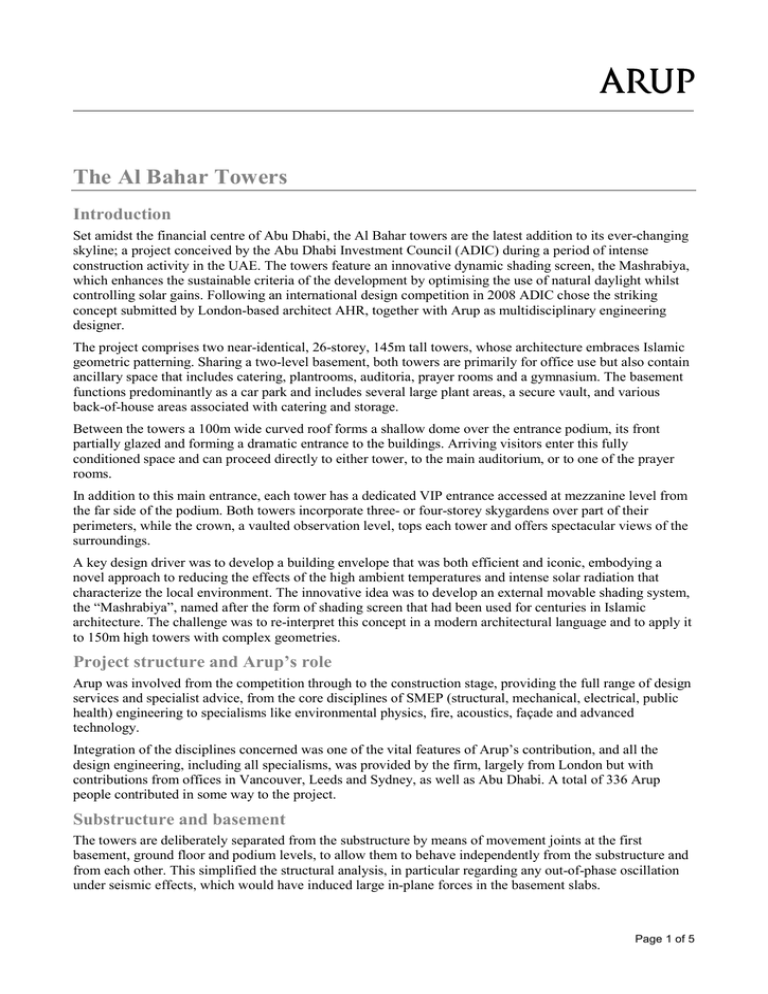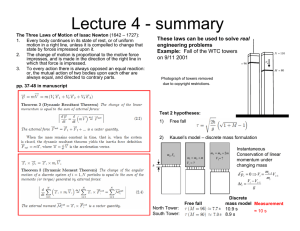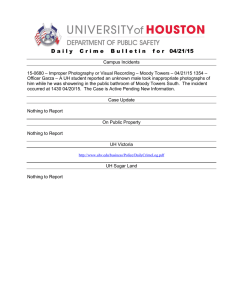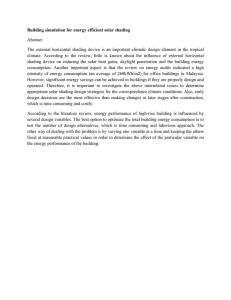The Al Bahar Towers
advertisement

The Al Bahar Towers Introduction Set amidst the financial centre of Abu Dhabi, the Al Bahar towers are the latest addition to its ever-changing skyline; a project conceived by the Abu Dhabi Investment Council (ADIC) during a period of intense construction activity in the UAE. The towers feature an innovative dynamic shading screen, the Mashrabiya, which enhances the sustainable criteria of the development by optimising the use of natural daylight whilst controlling solar gains. Following an international design competition in 2008 ADIC chose the striking concept submitted by London-based architect AHR, together with Arup as multidisciplinary engineering designer. The project comprises two near-identical, 26-storey, 145m tall towers, whose architecture embraces Islamic geometric patterning. Sharing a two-level basement, both towers are primarily for office use but also contain ancillary space that includes catering, plantrooms, auditoria, prayer rooms and a gymnasium. The basement functions predominantly as a car park and includes several large plant areas, a secure vault, and various back-of-house areas associated with catering and storage. Between the towers a 100m wide curved roof forms a shallow dome over the entrance podium, its front partially glazed and forming a dramatic entrance to the buildings. Arriving visitors enter this fully conditioned space and can proceed directly to either tower, to the main auditorium, or to one of the prayer rooms. In addition to this main entrance, each tower has a dedicated VIP entrance accessed at mezzanine level from the far side of the podium. Both towers incorporate three- or four-storey skygardens over part of their perimeters, while the crown, a vaulted observation level, tops each tower and offers spectacular views of the surroundings. A key design driver was to develop a building envelope that was both efficient and iconic, embodying a novel approach to reducing the effects of the high ambient temperatures and intense solar radiation that characterize the local environment. The innovative idea was to develop an external movable shading system, the “Mashrabiya”, named after the form of shading screen that had been used for centuries in Islamic architecture. The challenge was to re-interpret this concept in a modern architectural language and to apply it to 150m high towers with complex geometries. Project structure and Arup’s role Arup was involved from the competition through to the construction stage, providing the full range of design services and specialist advice, from the core disciplines of SMEP (structural, mechanical, electrical, public health) engineering to specialisms like environmental physics, fire, acoustics, façade and advanced technology. Integration of the disciplines concerned was one of the vital features of Arup’s contribution, and all the design engineering, including all specialisms, was provided by the firm, largely from London but with contributions from offices in Vancouver, Leeds and Sydney, as well as Abu Dhabi. A total of 336 Arup people contributed in some way to the project. Substructure and basement The towers are deliberately separated from the substructure by means of movement joints at the first basement, ground floor and podium levels, to allow them to behave independently from the substructure and from each other. This simplified the structural analysis, in particular regarding any out-of-phase oscillation under seismic effects, which would have induced large in-plane forces in the basement slabs. Page 1 of 5 The site is less than 200m from the sea, and this close proximity naturally results in a high water table. During construction this necessitated dewatering which commenced once excavation reached formation level and was cut off on completion of the substructure box. The substructure is protected from surrounding corrosive environment by a continuous membrane. To ensure stability at all phases of construction, the piles were designed to withstand a maximum tension equivalent to uplift less the self-weight of the substructure. Intermediate tension piles were introduced between column grids to alleviate the stresses arising on the slab at the lower basement level. Cooling systems The peak cooling load for the entire building is approximately 10.5MW, which is met by a series of four water-cooled chillers at basement level. Each incorporates two variable-speed compressors with the aim of maximising performance and efficiency. At peak daily conditions, all four chillers run at an optimal partial load. An independent secondary chilled water system acts as a resilient back-up cooling supply for businesscritical equipment and selected executive office areas. Under normal conditions this secondary system shares the cooling duty in these areas with the primary system, but should the latter fail, the electrically-driven and generator-backed secondary system increases its output to meet the additional cooling load. Podium/foyer The podium area between the towers incorporates the grand entrance lobby, central auditorium, male and female prayer rooms, back-of-house areas, two restaurants with associated kitchens, mezzanine level café, and plant. The structural shell roof enclosing this dramatic space is independent of the towers, and stabilised by raked reinforced concrete walls and a central reinforced concrete lift core. The diagrid typology, accommodating triangular soffit architectural inserts, defines the inner space and also enabled an efficient structural system. The structure was also conceived to facilitate the construction process, whereby it could be erected in only four parts. The steel mezzanine, with its composite deck, is suspended from the front edge of the overlying foyer roof. This space forms the cafeteria area and is directly above the heavily glazed main entrance. A lower “g” value and heavy fritting of the glass were incorporated in the glazing specification to reduce solar radiation ingress to manageable levels. The foyer space incorporates a large raised floor void which is used as a supply air plenum for a displacement-based HVAC system. Dedicated supply units pressurise the plenum with tempered air, and bespoke grilles integrated in the marble floors supply this air at very low velocity into the space, generating a cooling effect. Warm air rises and stratifies above the occupied zone at high level within the foyer’s vaulted envelope, where it is extracted back to the dedicated AHUs. Towers Due to the towers’ complex cylindrical shape, steel construction, and the extreme external ambient conditions, the team employed a co-ordinated approach using 3-D modelling to check both the spatial coordination of services in plant areas and that of services plant with structural elements at key “pinch points”. The towers are elliptical on plan and cylindrical in section. Stability is provided by the central 20.3m diameter cores which each accommodates a passenger and goods lifts, together with ancillary rooms, storage and plant, and thus freeing the floor plates for office use. Rigorous co-ordination during the early design stages allowed a constant core arrangement from the basement up to the crown at level 26 to be achieved. This repetitive core layout allowed the contractor to slip-form the concrete, resulting in the efficient construction rate of a floor every three to four days. The tower floor plates outside the cores accommodate open-plan office space, cellular offices and meeting rooms. Detailed co-ordination of the services integrated in the suspended ceiling, including grilles, lighting, Page 2 of 5 sprinkler heads, smoke detectors and occupancy sensors, resulted in an elegant system that both allowed straightforward installation and enables adaptability to future layout changes. Skygardens A key architectural feature of the towers is their skygardens, which are formed by the removal of the floors across two structural bays over four levels to create dramatic outward-facing environments. Resilient services systems As the primary business functions of the towers include financial transactions, brokering and dealing, resilience of the building services was a key consideration in the design. Each tower incorporates a data centre at level 2 and a series of sub-equipment rooms at each level of office accommodation. In terms of cooling and power supply, these facilities were designed to be highly resilient and able to continue operating in the event of primary system failure. This resilience is provided primarily by N+N system redundancy (i.e. each component has an independent back-up component) in terms of both cooling and electrical supply. Cooling is maintained by two wholly independent chilled water systems, while the electrical supply has both dedicated UPS (uninterruptable power supply) systems in each tower and diesel generator back-up. Vertical transportation An innovative vertical transportation strategy was adopted for the towers. The lifts are zoned normally for peak travel times. The low-rise lifts are for general staff use, and the high-rise for executive staff. Destination dispatch is used to enable the designers to allow all the lifts to act as a single group during peak times so as to handle the increased traffic flows in the morning and afternoon. During off-peak times, the lifts work as separate groups. Proximity access control is also provided to the high-rise lifts to facilitate the restricted access requirements for executives only. Tower façades: the Mashrabiya The climate in Abu Dhabi is classified as subtropical desert, and with maximum temperatures of around 46˚C and very high solar radiation levels year-round, reducing the energy use associated with providing internal comfort was perhaps the biggest single challenge faced by the design team. The answer was the innovative Mashrabiya shading devices with which the Al Bahar towers are wrapped; in fact the Mashrabiya became a key architectural theme in the towers’ design. Most recent high-rise buildings in the Middle East use highly glazed façades with dark, reflective, or bodytinted glass. This type of solution limits solar gain, but significantly reduces natural daylighting and general internal comfort. Frequent use of internal blinds is normally needed to control glare effects and this inevitably increases the lighting energy consumption, defeating the purpose of a transparent building. The Mashrabiya is, by contrast, a novel and sustainable feature, drawing inspiration in its design from the traditional shading screens of vernacular Islamic architecture. The design team undertook extensive solar and thermal analysis of the effect of this unique active shading system on select areas of the towers at various times through the year. As built, the Mashrabiya devices clad the towers on their east, south and west façades, significantly reducing solar gain to the internal accommodation and permitting the use of floor-toceiling clear glazing. In total each tower has 1049 Mashrabiya shading devices, each weighing about 1.5 tonnes. Arup built on knowledge gained in other projects with movable elements, and worked with the architect to conceive schematic parameters for these elements and their detailed performance specifications. The shape of the building in plan and elevation led to 22 different variations in the Mashrabiya geometries, which in itself created a challenge for managing their manufacture and assembly. The main technical challenge, however, was to develop a unique and unconventional movable shading device that not only Page 3 of 5 protected the buildings from the solar radiation, but could also operate reliably in an aggressive environment containing sand, dust and salt-laden air, and potentially prone to wind-induced movements. A series of prototype tests on the PTFE panels, conducted at both ambient laboratory and elevated temperatures, were used to check the required durability life of actuators, bearings and mechanisms that could be achieved. The result is a responsive and dynamic skin, able to react differently according to the sun’s orientation and to adapt to varying external conditions throughout the year. In consequence the building’s appearance itself is always changing, reflecting natural daily and seasonal rhythms. By detailed assessment of the combined shading and glass performances, a correct balance between solar control and light penetration was achieved. The type of glass selected has a clear appearance with high visible light transmittance, enhancing the daylighting and the view through, while the external shading panels help reduce the solar radiation significantly — and only where and when needed. The Mashrabiya elements are grouped in sectors and operate by sun tracking software that controls the opening and closing sequence according to the sun’s position. The system can be overridden to control individual panels. The control system is linked to an anemometer at the top of the building which will automatically prevent operation of the shading, and will retract the units if the wind speed exceeds the peak operating threshold. A similar approach, using solar radiation sensors, is used to trigger the opening of the Mashrabiya panels in prolonged overcast conditions. Various conceptual arrangements were assessed early in the design, including connecting all shading elements to one another and into the superstructure, but this led to conflicting behaviours between the Mashrabiya and the internal support structure. A more straightforward strategy was thus sought, in which each Mashrabiya was conceived as a unitised system cantilevering 2.8m from the primary structure. The supporting arms allow connection from the ends of six adjoining Mashrabiya, and each shading device has different releases at each of three supporting nodes. The curtain wall behind the shading is a standard unitised system, developed to accommodate variable building geometries. The design and overall shape of the building were optimised to improve the panel repetitions, limiting rectangularity deviation and any warping effect. This helped to significantly reduce the complexity of the system and ultimately the costs. The Crown The crown was the subject of a separate solar and thermal analysis, so as to optimise the Mashrabiya extension at this level, and verify where the external shading system would be required, to provide an efficient cooling strategy. Based on the 3-D model from the architect, Arup prepared a revised 3-D model of the tower to carry out the solar analyses. A simplified section of the top part of the tower was derived for a first solar exposure review, while a more detailed model was used for the sun path analysis. The solar exposure study suggested that at the top of the tower, the Mashrabiya system should follow the configuration already suggested for its lower portions. However, due to the architectural desire not to extend the Mashrabiya to the very top of the crown and due to the shading system’s distance from the façade, additional design measures were required to ensure that solar gains through the façade from level 26 to the top were reduced below the target limit. The glass performance in this area was improved by applying additional fritting with a variable pattern according to the level of solar control required. This reduced the g-value and contains the solar gains. Page 4 of 5 Dynamic behaviour Wind loading The elliptical/circular geometry of the buildings results in an efficient response under wind action. To determine the overall wind loads that would be acting on their superstructure, the two towers were tested at 1:300 scale in a wind tunnel at subconsultant åBMT Fluid Mechanics. These tests showed that a peak base bending of 550MNm was experienced at the base of the towers, 15% less than preliminary wind structural loads estimated using the UK wind code BS6399-21. Furthermore, the loads on the towers, if built in isolation, were found to be similar to or less than those when both towers were completed. The wind tunnel tests thus helped to reduce the structural steel weights required. Seismic loading Limited historical seismic events data exist for Abu Dhabi, so scientific opinion on the seismicity of the region varies depending on how the data from surrounding regions are extrapolated. The team carried out seismic analysis using seismic parameters and ductility, based on the Uniform Building Code, (Edition 1997)2, for a zone 2A seismic region as required by the Abu Dhabi Municipality. Later checks hazard assessment of the 2475-year earthquake return period, but with reduced levels of ductility (R factors). The seismic design was generally found to be less critical than that for wind action. Construction sequence Introducing movement joints around the towers at substructure levels enabled them to behave independently of one another and not rely on the substructure for stability. Apart from simplifying the analysis, this methodology facilitated the construction sequence, allowing the contractor to progress with the towers, which were on the critical construction path. They were built in parallel, with the steel skeleton lagging six floors behind the core, while the decks in turn were erected and concreted four floors behind steelwork. The efficient construction sequence, combined with round the- clock working, allowed the enabling works and shell structure to be completed in just over 12 months. Sustainability credentials The Al Bahar project is being assessed under the US Green Building Council (USGBC) LEED for New Construction version 2.2 (NC v2.2)3 and is predicted to achieve a Silver rating4. Under LEED the building is assessed in areas such as energy cost, land use, water use, occupant comfort and materials specification. Evidence is provided to the USGBC and points awarded when qualifying design/specification features are included or when performance exceeds a defined threshold. The final collated score determines the final LEED rating. The architect acted as the LEED administrator for the project and provided a LEED Accredited Professional to the project design team from an early stage to determine the target rating and advise the design team on specification and documentation requirements. Conclusion The Al Bahar towers are now a notable landmark in Abu Dhabi’s financial district. Their adaptable skins, the Mashrabiya, form a key feature of the project, responding to the external environment, considerably reducing heat gain, and enhancing sustainability credentials. The towers won the 2012 CTBUH Innovation Award5, and featured in the November 2012 Time magazine as one of the “25 best inventions of the year”6 — alongside NASA’s Curiosity Mars Science Laboratory rover. Page 5 of 5



